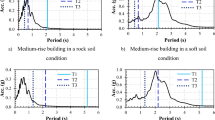Abstract
The objective of this paper is to investigate the influence of the coupling of torsional and soft-first-story effects to the seismic behavior of reinforced concrete frame buildings. For this purpose, several structural models, considering the variation of structural stiffness in the plane of each story and over the height of the structure, were generated. The effect of masonry infills non-uniformly distributed in plan was also examined. Each model was subjected to six strong ground motions acting, simultaneously, in two orthogonal directions. Inelastic dynamic analysis was performed. Results from 708 cases were exanimated, and useful conclusions concerning the inelastic response are derived.























Similar content being viewed by others
References
Brodsky, A., & Yankelevsky, D. Z. (2017). Resistance of reinforced concrete frames with masonry infill walls to in-plane gravity loading due to loss of a supporting column. Engineering Structures, 140, 134–150. https://doi.org/10.1016/j.engstruct.2017.02.061.
De Stefano, M., & Pintucchi, B. (2008). A review of research on seismic behavior of irregular building structures since 2002. Bulletin of Earthquake Engineering, 6(2), 285–308.
Dyaa, A. F. C., & Oretaa, A. W. C. (2015). Seismic vulnerability assessment of soft story irregular buildings using pushover analysis. Procedia Engineering, 125, 925–932.
Erdem, T. R. (2016). Performance evaluation of reinforced concrete buildings with softer ground floors. Građevinar, 68(1), 39–49.
Eurocode 8. (1998). Design of structures for earthquake resistance part 1: General rules, seismic actions and rules for buildings (ENV 1998-I-I). Berlin: CEN.
Goh, K. S., & Pan, T. C. (2015). Torsional response of nonductile structures with soft-first-story. Earthquake Engineering Structural Dynamics, 44(1), 1–21.
Kirac, N., Dogan, M., & Ozbasaran, H. (2011). Failure of weak-story during earthquakes. Engineering Failure Analysis, 18, 572–581.
Lavan, O., & De Stefano, M. (2016). Seismic behavior and design of irregular and complex structures. Geotechnical, geological and earthquake engineering. Dordrecht: Springer.
Lee, H. S., & Hwang, K. R. (2015). Torsion design implications from shake-table responses of an RC low-rise building model having irregularities at the ground story. Earthquake Engineering Structural Dynamics, 44(6), 907–927.
Mander, J. B., Priestley, M. J. N., & Park, R. (1988). Theoretical stress–strain model for confined concrete. Journal of Structural Engineering (ASCE), 114, 1804–1826.
Sahoo, D. R., & Rai, D. C. (2013). Design and evaluation of seismic strengthening techniques for reinforced concrete frames with soft ground story. Engineering Structures, 56, 1933–1944.
Seismosoft. (2014). SeismoStruct v7.0—a computer program for static and dynamic nonlinear analysis of framed structures. Available from http://www.seismosoft.com. Accessed 30 Aug 2014.
Sinkovič, K., Peruš, I., & Fajfar, P. (2016). Seismic assessment of RC frame buildings. In Z. Zembaty & M. De Stefano (Eds.), Seismic behaviour and design of irregular and complex civil structures II. Geotechnical, geological and earthquake engineering (Vol. 40). Cham: Springer. https://doi.org/10.1007/978-3-319-14246-3_8.
Teresa Guevara-Perez, L. (2012). Soft story and weak story in earthquake resistant design: a multidisciplinary approach. In Proceedings of the 15th world conference on earthquake engineering, Lisbon, Portugal.
Tomomi, S., Yoshiaki, N., Polat, G., Ho, C., Yasushi, S., Kazuto, M., et al. (2017). Experimental evaluation of the in-plane behavior of masonry wall infilled RC frames. Bulletin of Earthquake Engineering. https://doi.org/10.1007/s10518-017-0139-1.
Tsai, K. C., & Weng, Y. (2001). Computing story drift demands for RC building structures during the 1999 Chi-Chi Taiwan earthquake. The third U.S.–Japan workshop on performance-based earthquake engineering methodology for reinforced concrete building structures, Seattle, Washington.
Author information
Authors and Affiliations
Corresponding author
Rights and permissions
About this article
Cite this article
Ouazir, M., Kassoul, A., Ouazir, A. et al. Inelastic seismic response of torsionally unbalanced structures with soft first story. Asian J Civ Eng 19, 571–581 (2018). https://doi.org/10.1007/s42107-018-0043-2
Received:
Accepted:
Published:
Issue Date:
DOI: https://doi.org/10.1007/s42107-018-0043-2




